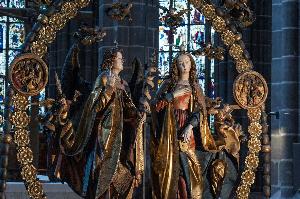Wit Stwosz
Wit Stwosz;Veit Stoß
Place: Horb Am Neckar
Born: 1447
Death: 1533
Biography:
Wit Stwosz, also known as Veit Stoß, was a prominent German sculptor who worked primarily with wood. His career spanned the transition between the late Gothic and Northern Renaissance periods, making him a significant figure in the art world. Born before 1450 and passing away around September 20, 1533, Wit Stwosz left an indelible mark on the world of sculpture.
Early Life and Training
Wit Stwosz's early life and training are not well-documented, but it is believed that he began his apprenticeship in a workshop, likely in Germany. He would have learned various techniques for working with wood, including carving, painting, and gilding.
Style and Influences
Wit Stwosz's style emphasized pathos and emotion, which was characteristic of the late Gothic period. His virtuoso carving of billowing drapery helped to create a sense of drama and tension in his works. This style has been referred to as "late Gothic Baroque." The Wit Stwosz is best known for the altarpiece in St. Mary's Basilica in Kraków, Poland.
Notable Works and Legacy
Some of Wit Stwosz's notable works include:
- The Virgin and Child with St Anne, a masterpiece of Gothic sculpture that can be found in the Deutsches Museum Berlin.
- The Carrot by Willem Frederik Van Royen, an oil painting that showcases the artist's attention to detail.
- The Street by Ernst Ludwig Kirchner, a powerful depiction of urban life that captures the energy and chaos of the city.
Wit Stwosz's legacy can be seen in his influence on later artists, including those who worked with him in his workshop. His style and techniques continue to be studied by art historians and scholars today.
Conclusion
Wit Stwosz was a significant figure in the world of sculpture during the late Gothic and Northern Renaissance periods. His emphasis on pathos and emotion helped to create a sense of drama and tension in his works, making him a master of his craft. To learn more about Wit Stwosz and his works, visit Wit Stwosz on Wikioo.org or explore the Staedtische Galerie im Lenbachhaus in Munich, Germany.




